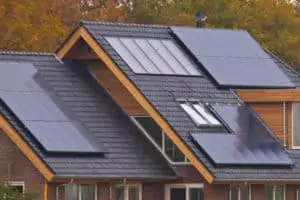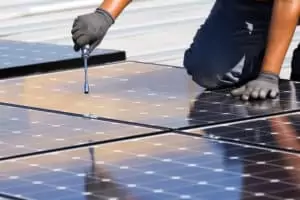
Monocrystalline solar panels stand as a pinnacle of efficiency and performance in the solar world. Crafted from a single crystal structure, these panels boast a uniform dark appearance and are recognized for their exceptional efficiency rates, making them an ideal choice for limited roof space.
With a manufacturing process that involves slicing a single silicon crystal, monocrystalline panels exhibit higher efficiency levels compared to other types. The uniformity of the crystal structure allows electrons to move more freely, resulting in better electrical conductivity and overall efficiency. Additionally, monocrystalline panels tend to perform better in low-light conditions, making them a dependable choice for regions with varying weather patterns.
Polycrystalline solar panels offer a compelling balance between affordability and performance. Made from multiple silicon fragments, these panels exhibit a characteristic blue hue and deliver solid efficiency levels.
The manufacturing process involves melting raw silicon and pouring it into molds, which creates multiple crystals that form the panel’s surface. While their efficiency might be slightly lower than monocrystalline counterparts, polycrystalline panels make up for it with a more budget-friendly price point. They are an excellent choice for those seeking a cost-effective solution without compromising significantly on energy production.
Solar inverters play a crucial role in the solar ecosystem by converting the direct current (DC) electricity generated by solar panels into alternating current (AC) electricity that can be used to power homes and businesses. The market offers various types of inverters, each catering to different installation setups and performance requirements.
These are the most common type of inverters and are often used in residential and small commercial installations. They connect to multiple solar panels in series (strings) and convert their combined DC output into AC power.
Microinverters are installed on each individual solar panel. They offer benefits such as panel-level optimization, meaning the performance of each panel is maximized independently. This setup is particularly useful when shading or panel-level variations are a concern.
Power optimizers, like microinverters, are installed at the panel level. They optimize the performance of each panel and then feed the DC power to a central inverter, enhancing system efficiency and flexibility.

To achieve maximum energy production, solar arrays are typically tilted at an angle that corresponds to the latitude of the installation site. This angle allows the panels to receive the most direct sunlight throughout the year, optimizing energy output. Solar tracking systems, which orient panels to follow the sun’s movement, offer even higher energy yields but are often more complex and expensive to implement.
Charge controllers, or solar regulators, are essential components in off-grid solar systems. They prevent overcharging of batteries by regulating the flow of electricity from solar panels to batteries. These devices extend battery life and enhance system reliability, making them indispensable for remote and standalone applications.
Charge controllers come in two main types: PWM (Pulse Width Modulation) and MPPT (Maximum Power Point Tracking). PWM controllers work by periodically interrupting the current flow to maintain a steady voltage in the batteries. MPPT controllers, on the other hand, track the maximum power point of the solar panels and adjust the voltage and current accordingly, allowing for more efficient energy transfer.
Solar batteries store excess electricity generated by solar panels during sunny periods for use during cloudy days or at night. As the demand for energy storage solutions grows, various types of batteries have emerged to meet different performance and capacity needs.
These are the oldest and most established type of rechargeable batteries. They are relatively affordable but have lower energy density and shorter lifespan compared to newer technologies.
Lithium-ion batteries have gained significant popularity due to their high energy density, longer cycle life, and lower maintenance requirements. They are commonly used in residential and commercial energy storage systems.
Flow batteries store energy in liquid electrolytes, offering scalability and longer cycle life. They are particularly suitable for large-scale applications and grid-level energy storage.
Solar combiners serve as connection points for multiple strings of solar panels, simplifying the wiring process and improving system efficiency. These devices combine the output of several panels before sending it to the inverter, reducing the complexity of system design and maintenance.
Combiners are equipped with fuses or circuit breakers for each string, allowing for individual string protection. This ensures that if an issue arises in one string, it does not affect the entire solar array’s performance. Combiners also facilitate easier monitoring and maintenance of the system’s components.

These mounts are stationary and positioned at a fixed angle. They are cost-effective and easy to install, making them suitable for installations with a consistent sun exposure angle.
Tilted mounts can be adjusted to different angles, allowing for optimization based on the seasonal sun path. This adjustability enhances energy production by adapting to changing sun angles throughout the year.
Tracking mounts actively follow the sun’s movement throughout the day, maximizing energy generation. While they offer higher energy yields, they are more complex and expensive to install and maintain.
Solar LED lights harness solar energy to illuminate outdoor spaces, eliminating the need for traditional grid-powered lighting. From garden lights to street lamps, solar LED lights offer an energy-efficient and eco-friendly lighting solution.
These lights consist of a solar panel, a battery to store the energy, an LED light source, and electronic components that control the light’s operation. During the day, the solar panel charges the battery, and the stored energy powers the LED light at night. Solar LED lights are a sustainable alternative for areas without reliable access to grid electricity.
Solar accessories encompass a wide range of components, including wiring, connectors, junction boxes, and monitoring systems. These accessories play a vital role in enhancing the overall efficiency, safety, and monitoring capabilities of solar energy systems.
High-quality wiring and connectors ensure efficient energy transfer between solar panels, inverters, and other system components. Properly sized and insulated wiring minimizes energy losses and ensures safe operation.
Junction boxes are essential for protecting the electrical connections between solar panels. They provide a secure enclosure that shields connections from environmental factors such as moisture and debris, enhancing the longevity of the system.
Advanced monitoring systems allow users to track the performance of their solar energy system in real-time. This includes monitoring energy production, consumption, and overall system health. Monitoring helps identify issues early and optimize energy usage.
Battery Box Enclosures: Protecting Energy Storage
Battery box enclosures provide a protective housing for solar batteries, shielding them from environmental factors and ensuring safe operation. These enclosures are designed with durability and ventilation in mind to maintain optimal battery performance.
Proper ventilation is crucial for dissipating heat generated by batteries during charging and discharging. Battery box enclosures feature ventilation mechanisms to prevent overheating and extend battery lifespan.
Enclosures protect batteries from physical damage, moisture, and dust. They also prevent accidental contact with live electrical components, ensuring the safety of both users and the system.

In conclusion, the solar industry is flourishing with an array of solar panel types and technologies that cater to diverse energy needs and preferences. Monocrystalline and polycrystalline solar panels stand out as two of the most prominent choices, offering varying benefits for different applications. As the solar landscape continues to evolve, advancements in solar inverters, batteries, charge controllers, and other components contribute to a sustainable and efficient energy future.
Remember, whether you’re aiming for top-tier efficiency with monocrystalline panels or seeking a cost-effective solution with polycrystalline panels, the solar industry offers a wide spectrum of options to power your journey towards clean and renewable energy.
For more in-depth information on specific topics such as Solar Inverters or Solar Batteries, feel free to explore our dedicated articles. Contact Strive Solar today for more details!
Disclaimer: This article serves as a guide and should not replace professional advice for specific solar energy projects.
